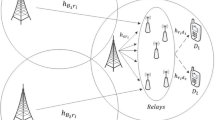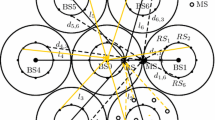Abstract
In this paper we propose a cooperative scheme in which fixed relays operate with a higher spectral efficiency than the source. The relay transmits L times faster than the source with L times the spectral efficiency, reducing the loss inherent to the orthogonal cooperation. We assume a large scale path loss model which is capable of handling with heterogeneous conditions between the nodes of the network: the source, the relay and the base-station antennas can be at different heights. Our results show that the proposed scheme consumes less energy while achieving up to 3 dB of gain, in terms of throughput, when compared to the baseline cooperative scheme. In addition, a coverage area analysis shows that the proposed scheme increases considerably the cell area when compared to the non-cooperative transmission and to the baseline cooperative scheme. Finally, we show that the proposed scheme, with a single relay, outperforms in the high signal to noise ratio region the regular cooperative scheme using multiple relays.
Similar content being viewed by others
References
IEEE Std 802.11 Std. (1999). Wireless LAN medium access control (MAC) and physical layer (PHY) specifications.
IEEE Std 802.16e Std. (2009). IEEE standard for local and metropolitan area networks part 16: Air interface for broadband wireless access systems.
Goldsmith A. (2005) Wireless communications (1st ed). Cambridge University Press, Cambridge
Foschini G. J. (1996) Layered space-time architecture for wireless communication in a fading environment when using multi-element antennas. Bell Labs Technology Journal 2: 41–59
Wolniansky, P., Foschini, G., Golden, G., & Valenzuela, R. (1998). V-BLAST: An architecture for realizing very high data rates over the rich-scattering wireless channel. In Proceedings URSI international symposium on signals, systems, and electronics, pp. 295–300.
Sellathurai M., Haykin S. (2002) Turbo-BLAST for wireless communications: Theory and experiments. IEEE Transactions on Signal Processing 50(10): 2538–2546
Tarokh V., Seshadri N., Calderbank A. R. (1998) Space-time codes for high data rate wireless communication I: Performance criterion and code construction. IEEE Transactions on Information Theory 44: 744–765
Alamouti S. (1998) A simple transmit diversity technique for wireless communications. IEEE Journal on Selected Areas in Communications 16(8): 1451–1458
Tarokh V., Jafarkhani H., Calderbank A. R. (1999) Space-time block codes from orthogonal designs. IEEE Transactions on Information Theory 45: 1456–1467
Zheng L., Tse D. (2003) Diversity and multiplexing: A fundamental tradeoff in multiple antenna channels. IEEE Transactions on Information Theory 49: 1073–1096
Freitas W. C. Jr., Cavalcanti F. R. P., Lopes R. R. (2005) Hybrid transceiver schemes for spatial multiplexing and diversity in MIMO systems. SBrT/IEEE Journal of Communication and Information Systems 20(3): 63–76
Laneman J., Wornell G. (2002) Distributed space-time coded protocols for exploiting cooperative diversity in wireless networks. IEEE Global Telecommunications Conference 1: 77–81
Sendonaris A., Erkip E., Aazhang B. (2003) User cooperation diversity - part I: System description. IEEE Transactions on Communication 51(11): 1927–1938
Laneman J. N., Tse D. N. C., Wornell G. W. (2004) Cooperative diversity in wireless networks: Efficient protocols and outage behavior. IEEE Transactions on Information Theory 50(12): 3062–3080
Nosratinia A., Hunter T. E., Hedayat A. (2004) Cooperative communication in wireless networks. IEEE Communications Magazine 42(10): 74–80
Bhatnagar M., Arti M., Hjørungnes A., Bose R., Song L. (2010) Multi-user relaying of high-rate space-time code in cooperative networks. Wireless Personal Communications 54: 69–81
Su W., Sadek A. K., Liu K. J. R. (2008) Cooperative communication protocols in wireless networks: Performance analysis and optimum power allocation. Wireless Personal Communications 44(2): 181–217
Zhao B., Valenti M. C. (2005) Practical relay networks: A generalization of hybrid-ARQ. IEEE Journal on Selected Areas in Communications 23(1): 7–18
Krikidis I. (2007) Distributed truncated ARQ protocol for cooperative diversity networks. IET Communications 1(6): 1212–1217
Zhang C., Wang W., Wei G. (2009) Design of ARQ protocols for two-user cooperative diversity systems in wireless networks. Elsevier Computer Communications 32(6): 1111–1117
Zheng K., Hu L., Wang W., Huang L. (2010) Performance analysis of HARQ transmission in cooperative DF relaying systems. Wireless Personal Communications 55: 441–455
Sartori, P., Baum, K., Classon, B., & Cudak, M. (2005). Improving the uplink data rate of portable devices in broadband systems with relaying. In IEEE 62nd Vehicular Technology Conference, 4(25-28), 2542–2546
Sadek A., Han Z., Liu K. (2010) Distributed relay-assignment protocols for coverage expansion in cooperative wireless networks. IEEE Transactions on Mobile Computing 9(4): 505–515
Ichitsubo, S. (1996). 2 GHz-band propagation loss prediction in urban areas; antenna heights ranging from ground to building roof. IEICE, Technology Rep.
Kramer G., Gastpar M., Gupta P. (2005) Cooperative strategies and capacity theorems for relay networks. IEEE Transactions on Information Theory 51(9): 3037–3063
Cover T. M., Thomas J. A. (1991) Elements of information theory (2nd ed.). Wiley, Hoboken
Khormuji M., Larsson E. (2009) Cooperative transmission based on decode-and-forward relaying with partial repetition coding. IEEE Transactions on Wireless Communications 8(4): 1716–1725
Stanojev I., Simeone O., Bar-Ness Y., You C. (2006) Performance of multi-relay collaborative hybrid-ARQ protocols over fading channels. IEEE Communications Letters 10(7): 522–524
Author information
Authors and Affiliations
Corresponding author
Rights and permissions
About this article
Cite this article
de Oliveira Brante, G.G., Pellenz, M.E. & Souza, R.D. Spectrally Efficient Incremental Relaying for Coverage Expansion in Cellular Networks with Heterogeneous Path Loss Conditions. Wireless Pers Commun 64, 811–829 (2012). https://doi.org/10.1007/s11277-011-0221-y
Published:
Issue Date:
DOI: https://doi.org/10.1007/s11277-011-0221-y




